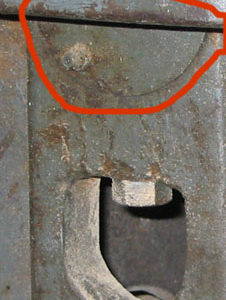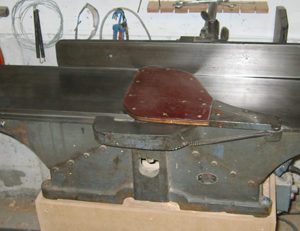A while ago I bought an old 9″ jointer, (still don’t know who the mfg was) and the bearings have started to get a little noisy. At first I assumed they were babbit bearings because of the grease fittings on them, but I’m not so sure now because if they were babbit bearings, they should be able to be split apart for when they need to be repoured, right? I’m very sure they aren’t ball bearings, as there is no evidence of an inner or outer race, or a shield for the balls. All they look like are two round peices of steel which house the ends of the cutterhead, and they get bolted right to the machine. There is also minimal axial and radial play (about .001″) so the ends of the cutterhead can’t just be sitting inside a straight bore.
I want to replace these bearings with new ball bearings, but I don’t want to ruin the cutterhead taking the old bearings off (not even sure what the proper way to remove these bearings is). BTW, I have regreased them, but they still seem to be making some noise. Do any of you guys have an idea as to what type of bearings these are? Also, if you could tell me who made this jointer it would be greatly appreciated.
Here is a closeup pic of one of the bearings, and a pic of the entire jointer.
Andrew

















Replies
I haven't a clue but think it may be old like 1920's maybe? But really just a guess
Go to this site and post a pic. im sure they will know who made it and how old it is
http://oldwwmachines.com/
I think if it had babbit bearing it would have oil cups.
If it was me and it still did a good job would use it like it is and keep it well greased.
I like using old tools wish I had more old stuff.
Lets us know what you find out about it.
On machines of similar style there are conventional ball bearings inside of cylindrical housings. Each housing is held in place on the main casting by a vertical bolt, one of which is showing in the photo of the bearing. Removing the two bolts directly below the bearings will allow you to lift the cutter head and the two bearing assemblies off the machine as a unit. You aren't seeing the bearings because they are pressed into the housings from the outside. The inside faces of the houses are only bored to just clear the cutter head shaft, which helps to keep dirt away from the bearings.
Hope this helps, I'd be curious to know if I'm correct.
John W.
I concur with John. Remove the bolts from under the bearings and the whole head should lift out. Should be a standard ball bearing. Babbitt bearing housings take up a lot more room and look different than what you have. If you don't know what to do then get a machine shop or mechanic to help. I'd bet that jointer was made in the 50's. That seems when the home shop wood machines began to be produced. Good for you for posting the pictures. So many posters don't give enough information to give good answers.
John and Rick, you guys were right, they are ball bearings. I took the cutterhead off last night and cleaned out some of the grease and dust that had stuck between the cutterhead and the bearing housing, and then looked in with a bright light. There is only about 1/8" between the cutterhead and the bearings so it's hard to really see what's in there. I just hope that the bearings come out on the cutterhead shaft, and don't stick in the blind bore. That could be a real pain to take out. before I knew all this I was going to machine a new housing for some ball bearings, so this has saved me some work. The million $ question still remains though, who was the manufacturer? I posted pics over at http://www.owwm.com but no one has had any ideas yet.
Looks like an Atlas Machine to me. But just a guess. (Could have also been a Sears machine made by Atlas is the 1950's time frame.) Why do you care who made it? Bearings should be standard.
If it is working OK, why not leave alone -- let a sleeping dog lie.
deblacksmith
Like I said before take it to a machinist or even your local auto mechanic. It's ten minute job to remove and replace the bearings with the right tool and know how. Who made it is worth about ten cents as long as it works. I don't think Sears had anything to do with that tool. I have some Sears catalogs from the 50's and the biggest they show is a 6" jointer. Chances are the company that made it is out of business and all you can get are knives and basic screws from other sources. Anything else will have to be fabricated if broken. Don't be surprised if it has metric bearings. Was doing machine restoration long before owwm and had to gather my own paperwork. Have trade magazines, pattern making supply catalogs and Vocational texts going back to 1880. Not conclusive by any means, but I took a quick look and couldn't find anything that resembled your jointer. That machine should outlast you by many years if you take care of it.
The reason I want to know who made it is mainly just curiosity. It's the only 9" jointer I've ever seen and it's a bit of an odd ball, so it would be cool to know a bit about its history. I know that its a imperial bearing because the shaft is dead on .750", and replacing them won't be a big deal. I've replaced bearings before, but I wasn't sure I would know how to do anything other than ball and babbit bearings. BTW, metalworking is another hobby of mine, and I've worked in a few tool and die shops, so making any new parts isn't a big deal.
Andrew
Andrew, an old trick to remove blind hole bearings is to turn down a brass shaft to a 'running fit for those bearings.
Chamfer the leading end a little. Fill the recess half way with heavy grease and place the 'piston' in the hole and hit it with a brass hammer.
I'm sure you're familiar with the mechanics of hydroulics, so I won't belabor the point. Stein.
It does my heart good to find guys that tackle jobs like you do., instead of being a slave to imports from Taiwan.
Everyone should bone up on metalurgy/hardness ,heat treatment,and high speed steel versus (cold rolled)to be able to appreciate good quality machine tools and the artists who create and produce them.
Everytime I see a cast iron hammer /vise/ or clamp for sale at any price, I say, "This junk's for chumps"
Oh yeah, and those cheesy socket wrenches and allen wrenches made in someones backyard in Catmondu from old sash weights. Stein.
How do the Canadian made Generals fit in your view of things?
This forum post is now archived. Commenting has been disabled